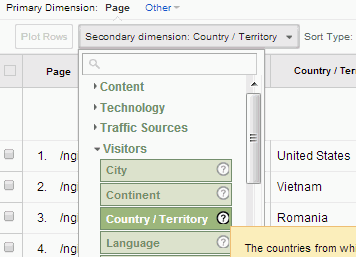Secondary Dimension in Google Analytics: Best Practices and Tips
Secondary Dimension in Google Analytics: Best Practices and Tips
Blog Article
Transform Your Analytics Technique With Second Dimension in Google Analytics
Checking out the possibility of secondary measurements in Google Analytics opens up a realm of opportunities for services looking for to raise their logical approach. By incorporating additional measurements into data evaluation, a new layer of understandings emerges, dropping light on complex customer habits and interactions. This innovative degree of analysis not only fine-tunes marketing strategies but likewise deciphers concealed opportunities for optimization and growth. The calculated application of secondary dimensions holds the crucial to opening a bonanza of invaluable information that can change just how businesses analyze and act upon their data.
Comprehending Secondary Dimensions in Google Analytics
Secondary dimensions in Google Analytics supply added context to main information by allowing individuals to evaluate metrics throughout a 2nd dimension, using much deeper insights right into customer habits and communications on a web site. Secondary Dimension in Google Analytics. While key measurements offer basic data points such as pageviews, bounce price, and session period, second measurements supply a more in-depth sight by segmenting the primary data further. This division enables users to evaluate metrics in mix with an additional dimension, such as web traffic resources, demographics, or user behavior
Benefits of Utilizing Secondary Measurements
Using additional dimensions in Google Analytics provides a strategic benefit by enhancing the deepness of evaluation and offering an extra thorough understanding of individual interactions and actions on a site. By incorporating secondary measurements, analysts can acquire useful understandings right into the performance of certain sections or variables within their data. This enables a more in-depth exam of customer actions past surface-level metrics, permitting for a much deeper exploration of the factors affecting customer engagement and conversions.

How to Carry Out Secondary Measurements
When integrating second dimensions in Google Analytics, one crucial step is to choose the pertinent metrics and dimensions to enhance the evaluation process. Clicking on this button will open up a drop-down food selection listing numerous dimensions that can be added to your main measurement for deeper insights.
After choosing the ideal secondary dimension, such as 'Source/Medium' or 'Device Category,' Google Analytics will certainly present the data in a more comprehensive style, enabling you to cross-analyze various facets of user behavior. Remember to explore different combinations of additional and main measurements to reveal valuable patterns and fads that can notify your advertising and marketing approaches. By applying second measurements attentively, you can obtain an extra comprehensive understanding of your internet site or application performance and make data-driven decisions to optimize your digital presence.
Analyzing Information With Second Measurements
Boost your information analysis in Google Analytics by incorporating second measurements to delve much deeper right into user actions patterns and enhance your electronic advertising and marketing approaches properly - Secondary Dimension in Google Analytics. By adding secondary measurements to your primary information, you can acquire valuable understandings that can aid you make educated decisions about your internet site or app efficiency
Examining data with additional dimensions permits you to segment your key data better, supplying a more detailed view of individual interactions. Combining the main measurement pop over to this site of 'source/medium' with a second dimension like 'landing page' can disclose which details pages are driving web traffic from various resources. This info can be crucial in fine-tuning your content technique or maximizing your advertising campaigns to boost conversions.
Additionally, making use of secondary dimensions allows you to identify connections in between various metrics, helping you comprehend the impact of numerous aspects on customer actions. Whether it's evaluating demographics along with user interaction metrics or tool groups with conversion prices, secondary dimensions empower you to uncover covert patterns and patterns that can assist your advertising initiatives.
Enhancing Efficiency With Additional Measurements
To enhance the efficiency of information evaluation and decision-making in Google Analytics, integrating additional measurements is crucial to optimizing performance metrics and gaining deeper insights into user behavior patterns. By utilizing secondary dimensions, analysts can delve beyond surface-level data and uncover important correlations that may otherwise go unnoticed. This optimization technique allows services to customize their advertising initiatives better, identify locations for renovation in site functionality, and enhance overall user experience.
Second measurements supply a more extensive sight of user interactions by giving added context to main data metrics. Matching the key dimension of 'touchdown page' with a secondary measurement like 'device classification' can reveal whether specific devices are extra likely to drive engagement on certain landing web pages. This insight can educate responsive layout enhancements or targeted advertising approaches to improve efficiency.

Conclusion
Finally, the combination of secondary measurements in Google Analytics supplies companies with an effective tool to boost their analytics method. Secondary Dimension in Google Analytics. By delving deeper right into user actions and interactions, marketers can reveal important understandings that can drive performance optimization and boost the overall customer experience. Leveraging secondary measurements permits an extra over at this website extensive analysis of data, leading to more informed decision-making and tailored advertising initiatives
Additional measurements in Google Analytics provide extra context to read this key data by enabling customers to examine metrics throughout a second dimension, supplying deeper insights right into user habits and communications on a site. While main measurements offer basic data factors such as pageviews, bounce rate, and session duration, additional measurements supply a more comprehensive sight by segmenting the key information even more.One of the essential advantages of using additional measurements is the capacity to reveal correlations and patterns that may not be quickly apparent when evaluating data with main measurements alone.When including second dimensions in Google Analytics, one vital action is to select the relevant metrics and measurements to improve the analysis procedure. Pairing the primary dimension of 'touchdown web page' with a second measurement like 'tool group' can disclose whether particular tools are extra most likely to drive involvement on details touchdown web pages.
Report this page